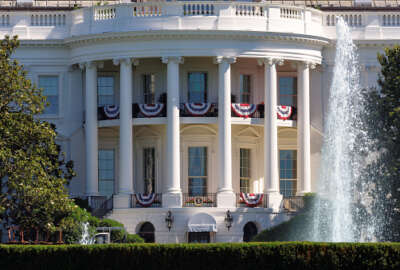
Why it’s a good time to be a federal contractor
PV Puvvada, the president of Unisys Federal, discusses in Federal News Radio’s new show, Views from the Corner Office, the trends and challenges of being a...

Best listening experience is on Chrome, Firefox or Safari. Subscribe to Views from the Corner Office’s audio interviews on Apple Podcasts or PodcastOne.
Views from the Corner Office is a new show designed to talk to the private sector leaders that influence and impact the federal market. The goal of this monthly discussion is for federal executives, lawmakers and other industry experts to gain insights and a better understanding into the trends, the challenges and the evaluation of the technology, acquisition and leadership in the federal market by the executives who lead the federal practices of government contractors.
PV Puvvada, the president of Unisys Federal and the show’s first guest, sat down with Federal News Radio Executive Editor Jason Miller at the Federal News Radio’s studios in Washington, D.C.
Here are some excerpts from that discussion.
State of the federal market
JM: Talk about what you’re seeing, what impacts you have and what is impacting you. Give us a state of the union, if you will, of the federal market. Is it a good time to be a government contractor?
PV: Yes. It’s a good time to a government contractor providing IT services and other professional services. Just to give you a little bit of the sense of the challenges that we face as partners to the government, agencies center around budget uncertainties. It doesn’t really help not having a budget. The contracting officers have to spend a lot of their time doing modifications to get these incremental funding through continuing resolutions (CRs), and it turns up a lot of time, as well as our clients’, cannot focus on their long-term priorities. They cannot plan from a horizon for the full year, so it’s a big challenge that everybody’s facing, and then moving into several openings in key government positions, kind of slow down strategic initiatives that kind of lead to very slow acquisition cycle. In addition to existing significant challenges and workforce challenges in our market to retain and recruit talent is a big challenge for all of our companies.
On the continuing use of CRs
JM: Talk a little about what this budget uncertainty does for you as a government contractor and you and other that you work with in the government market.
PV: We are on the back end of these decisions, as somebody that is providing services and solutions as contractors. It presents a challenge on the stability of our workforce, planning their vacations to planning their time, and it comes down to communication, having an incident response in terms of any that happens. At the end of the day, several of us operate mission critical systems that are critical to the national security or critical to some of the operations that will continue, so we have to play the balance of understanding on a regular basis, every single step of the way, which ones are going to be essential, and which ones are not going to be essential. It just makes it harder to kind of have stability in the market because a lot of folks, as the economy improves, in the commercial market, a lot of folks don’t have to deal with that sort of thing, so sometimes it loses its attractiveness.
JM: Why aren’t you guys, and I know you can’t speak for everybody, but why aren’t the Professional Services Council, which you now are on the board of. Why isn’t ITAPs? Why isn’t the Coalition for Government Procurement and not just from an industry association perspective, but why aren’t the companies making a bigger to-do over these budget problems? Explaining to the people on Capitol Hill and to the administration that when you do this, this is what happens. The trickledown effect is not just to the 800,000 federal employees, but it’s to the million and a half, 2 million or 5 million government contractors?
PV: That’s a good point. In general, I think we do a good job of educating both the White House, the agencies as well as the congressional stakeholders. Perhaps, we need to do a better job of making it visible, but people understand, that there is an impact to it and that is an impact to the overall economic strength that comes from the number of millions of people that get furloughed. So associations like PSC, which you mentioned that I’m going to be chairman of [in 2018], this is one of the top agenda items. I don’t think anybody disagrees with the impact it has. It’s just matter of, where you are in politically in what budget compromise both parties in the White House are trying to accomplish.
On the status of the federal market
JM: Talk about that evolving business model and how you are adjusting to those new technologies, the new regulations, new laws and everything that’s kind of coming together at once?
PV: Competitively, it is a very tough market. So as a nature of it, that also leads to a very price-sensitive than this. So you got to have the right business model for each one of the companies, the market that you’re playing. So obviously cost structure, how you deliver and how you grow and what can of scale, what kind of platform do you have, all play into the business model.
From our perspective, we focus on three things with our business model. Obviously, you have to be very lean and efficient, but we want to think about reinventing ourselves in ways that are interesting. And we have taken an innovation in our internal business processes as a priority. It’s not just about lower overheads or lower internal processes. We wanted to look at everything that we do internally and wanted to streamline, use automation, use tools and build that agility, so that we can really focus our energies on not worrying about the cost as much and worrying about the agility just as much.
We have streamlined every single process over the last couple of years and questioned does this process need to be there? What can we do better with a relentless focus on this reinventing business process innovation.
We wanted to take away the churn that happens internally within the companies and really focus around the mission and the way we serve the clients. So you normally don’t think of this as a business model but this is an important element of the business model.
The second element of business model is what platform do you have as companies? You can do lots of things to build that platform and scale. For us, our business model is just as important about not about how big that platform is, is just important about what you focus on. So our business model is around focusing on target clients. We know what our strengths are. We know what our capabilities are. We know the mission of it is target clients and we know where the areas to serve those clients in an expanded capability. So we have established a strict discipline as part of our business model and not take on targets that are not part of our plan or strategy. So to maximize that effectiveness of our business model, we centralize lots of resources and still give authority to our client facing teams, that serve clients and deliver to the clients to have the approval authority. So by centralizing all our investment and resources for growth as well as for our delivery, that allows us to find this balance of focus but also get this scale which otherwise you get fragmented in terms of where you’re going.
On the trends in federal procurement
JM: What about the business model for government? What are you seeing in terms of how you’re bidding and proposing and what does the government expect? You mentioned agile, both in procurement and agile in delivery, but beyond that, are you seeing a trend in the requests for proposals and the bids and the other procurement actions?
PV: We’re at an interesting time in terms of an inflection point with the government looking for a business model. Government is more and more interested in as-a-service. It’s not just about a cloud base kind of thing. It’s generally leading toward if you want to be agile, provide me as service on an agile team and take responsibility for delivering me certain elements of the capabilities that we need. So, and more of that happens and I think your business model and the company’s side need to shift to, well, it’s not just about providing six staff, it’s about providing that service as a service in a way that is advantageous to the clients. The other thing that we’re seeing is most people would like to see a results-oriented statement of objective approach as opposed to a statement of work (SoW) that tells you how many people that you need, and what kind of people that you need.
So I think we’re still in the transition, but the forward leaning agencies that really want to focus on, ‘I want to hold you accountable for the objectives.’ You define the objectives and they tell us how they aligned to what I need to get done is a trend that’s happening, but not quite there yet. It requires a lot of work to define and understand how to evaluate [bids] as opposed to a very prescribed set of staff.
On a personal note
JM: Tell me something about yourself that nobody knows that maybe a little more personal when you’re not focused on federal news. What else do you do?
PV: People may not know this, but I’m a cricket fanatic. As, obviously, most of the listeners would know that the game of cricket is not popular here, but it’s a very popular game in the British commonwealth countries in south Asia, Australia, New Zealand, England, South Africa. So I grew up playing and became a big fan. So nowadays with the internet, and with satellite television, you got to follow it.
Copyright © 2025 Federal News Network. All rights reserved. This website is not intended for users located within the European Economic Area.
Jason Miller is executive editor of Federal News Network and directs news coverage on the people, policy and programs of the federal government.
Follow @jmillerWFED
Related Stories






